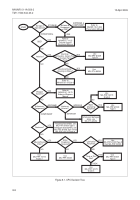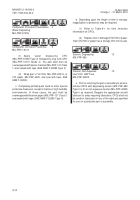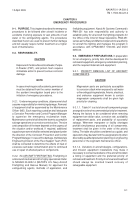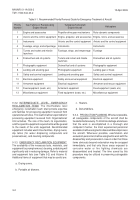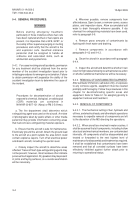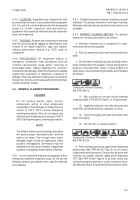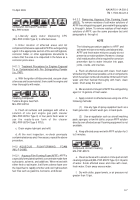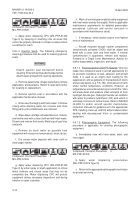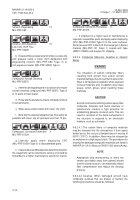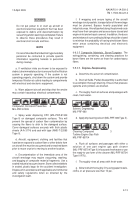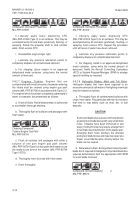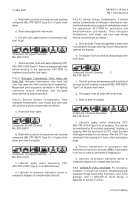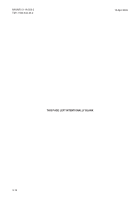TM-1-1500-344-23-2 - Page 162 of 240
9-8
NAVAIR 01-1A-509-2
TM 1-1500-344-23-2
15 April 2009
Compound, Corrosion Preventive
4
MIL-PRF-81309
g. Apply
water
displacing
preservative
(MIL-PRF-81309 Type III) to all avionic components
and electrical connectors. Liberally apply water
displacing CPC (MIL-PRF-81309 Type II) to all other
areas that cannot be properly drained or have recesses
which are difficult to reach.
h. Enter location of affected areas and list
components that were exposed to AFFF fire
extinguishing agent in the appropriate section of the
aircraft logbook, corrosion folder, or other appropriate
documents to ensure that the area is re-inspected in the
future as a corrosion prone area.
9-6.3. CARBON DIOXIDE, HFC-125, AND HALON
FIRE EXTINGUISHING AGENTS.
9-6.3.1. Carbon Dioxide (CO
2
). Carbon dioxide is a
dry, non-corrosive, inert gas that is used on flammable
liquids and electrical fires because it does not leave any
residues which might further harm the damaged electrical
equipment. Also, CO
2
is ideal for use on fires when it is
important to avoid water damage. CO
2
works by reducing
the amount of oxygen available for combustion by
smothering it. Although CO
2
is non-poisonous,
asphyxiation can result from breathing it and supplied
air must be worn when CO
2
is used below decks or in
confined spaces.
9-6.3.2. HFC-125 (Pentafluoroethane). HFC-125 is a
fluorocarbon fire extinguishant that is electrically non-
conductive, non-corrosive, free of residue, has zero
ozone depletion potential (ODP), and is an
environmentally approved replacement for Halon
systems. HFC-125 works by absorbing the heat
generated from the combustion reaction.
9-6.3.3. Halon 1211 (Bromochlorodifluoromethane)
and Halon 1301 (Bromotrifluoromethane). Halons are
colorless, odorless gases. They will extinguish most
type of fires without leaving a residue and are suitable
for discharge in confined spaces. Typically, they are
used in areas that contain sensitive or irreplaceable
equipment that could be damaged or destroyed by
water, foam, dry chemical, or carbon dioxide. Like PKP,
Halons do not extinguish by smothering or cooling,
instead they interrupt the chemical reaction of the fire as
it decomposes upon contact. Halons have been found
to be an ozone depleting agent; however, some Halons
are still required for aircraft and shipboard applications
as no safe and effective alternative exists. Halon 1211
extinguishers are marked with a reflective silver band
around the tank.
NOTE
Carbon Dioxide, HFC-125, or Halon fire
extinguishing agents will not leave residues.
However, smoke, smudges, or other grime
from a fire is corrosive and shall be removed
from affected items that are to be retained for
future use.
9-6.3.4. CO
2
, HFC-125, Halon 1211 and Halon 1301
evaporate rapidly. Therefore, no cleanup is required
unless moisture or high temperature was present at the
area of application. However, ventilation should always
be provided to remove the vapors. If moisture or high
temperature was present, use the following clean-up
procedures.
a. After fire has been extinguished, purge area and
surface with clean, dry air (dust free, low moisture
content, compressed air).
Compound, Aircraft Cleaning
2
MIL-PRF-85570
b. Clean surfaces with a solution of one part aircraft
cleaning compound (MIL-PRF-85570 Type II) in 14 parts
of water. Scrub affected areas and rinse with clean,
fresh water. Drain away excess water.
c. Dry with cloths, paper towels, or air pressure not
greater than 10 psi.
Compound, Corrosion Preventive
4
MIL-PRF-81309
d. Apply
water
displacing
preservative
(MIL-PRF-81309 Type III) to all avionic components
and electrical connectors. Liberally apply water
displacing CPC (MIL-PRF-81309 Type II) to all other
areas that cannot be properly drained or have recesses
which are difficult to reach.
Back to Top

